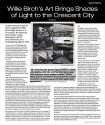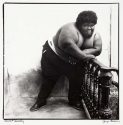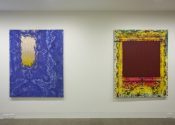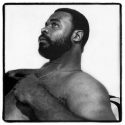Gallery News
Francis Pavy: Retrospective at the 1911 Historic City Hall Arts & Cultural Center in Lake Charles
The City of Lake Charles will host Retrospective by Francis Pavy at the 1911 Historic City Hall Arts & Cultural Center at 1001 Ryan Street. The nationally known artist be on hand to meet and greet during the opening reception on Friday, September 7 from 5:30-8 p.m. The exhibition will hang through November 10.
Holton Rower: Pour Painting
“Willie Birch’s Art Brings Shades of Light to the Crescent City,” New Orleans Living
Birch moved back to the Crescent City in the early 90s after receiving a Guggenheim grant to produce a body of work based on growing up in New Orleans. He bought and gutted a property on N. Villere Street, which eventually became his studio space. The old stomping grounds of Mardi Gras Indian Chief Tootie Montana and jazz legend “Jelly Roll” Morton, Birch couldn’t have felt more at home. He began compiling life-sized color portraits of African Americans, but his work has since evolved into black and white through use of acrylic and charcoal on canvas.
“Just (a few more) Kids: George Dureau, Robert Mapplethorpe and Company,” Jeu de Paume
Dureau, on the other hand, was a people person, not an aesthete like either Mapplethorpe or Weston. His pictures breathe, they pulse, they are hot with the blood and sweat of the sitters who joined him in his apartment on Esplanade Street in the city where he was born, and sometimes posed with props that were part of his personal effects. Edward Lucie-Smith, who wrote a fine introduction to a book of Dureau’s photographs published in the 1980s, compared the artist’s ability to transform these autobiographical encounters into photographically classical pictures with the writing strategies of Baudelaire, most notably in the Tableaux Parisiens of Les Fleurs du Mal.
“Artist Mark Flood makes a rare appearance at…his own exhibition,” CAPITAL NY
Flood’s most recent works are his “lace paintings,” which he’s been at for more than a decade now. Originally conceived as backdrops for his text incitements, the lace paintings took on their own life. Painted in acrylic on canvas, the images are created by using tattered lace pieces—sourced from thrift and fabric shops—as stencils. They are dipped in paint, then spread on the canvas, then painted over, then removed (the timing for removal is evidently key). They are intricate, delicate, technically innovative, and abuzz with color: wholly unlike anything else he’s done. They have certainly become highly sought-after and are largely responsible for the invigoration of his career.
“No ‘Sacred Monster,’ Just a His-Way Artist,” New York Times
To call someone an artists’ artist is often just a craven way of saying, “Sorry about your career.” But over the past two decades the Houston painter and punk propagandist Mark Flood, 54, has fit the bill, beating a fevered pulse beneath the work of many younger artists, who have been inspired by his anarchic humor and disturbing vision of contemporary culture.
Review of “George Dureau, Black: 1973-1986,” photograph
George Dureau’s Black, at Higher Pictures through July 13 is a jewel of an exhibition comprised of only 15 black-and-white prints. Though the artist is in his eighties, and though the photos on view are from the ’70s and ’80s, for many of us, this small show serves as an introduction to Dureau’s work.
“George Dureau: ‘Black 1973-1986’,” New York Times
The first New York exhibition of George Dureau’s black-and-white photographs, mostly of bare-chested or nude young men, is long overdue. Mr. Dureau, who was born in New Orleans in 1930 and has lived most of his life there, began taking them in the early 1970s. The photographs were partly intended as studies for his figurative paintings, which they tend to overshadow.
“Pavy & Perelli: Louisiana Essences,” New Orleans Art Review – Winter/Spring 2012
Review of March 2012 exhibits “Francis X. Pavy: 200 – Art Inspired by 200 Years of Louisiana Statehood” and “Keith Perelli: Mosquito Muerto”.










